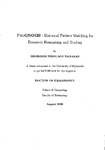PROGNOSIS - Historical Pattern Matching for Economic Forecasting and Trading
| dc.contributor.author | BANAVAS, GEORGIOS NIKOLAOS | |
| dc.contributor.other | Faculty of Science and Engineering | en_US |
| dc.date.accessioned | 2013-09-10T12:27:18Z | |
| dc.date.available | 2013-09-10T12:27:18Z | |
| dc.date.issued | 2000 | |
| dc.identifier | NOT AVAILABLE | en_US |
| dc.identifier.uri | http://hdl.handle.net/10026.1/1642 | |
| dc.description.abstract |
In recent years financial markets have become complex environments that continuously change and they change quickly. The strong link between the continuous change in the markets and the danger of losing money when trading in them, has made financial studies a domain that concentrates increasing scientific and business attention. In this context, the development of computational techniques that can monitor recent financial events can process them according to their similarity with historical data recordings, and can support financial decision making, is a challenging problem. In this work, the principal idea for tackling this problem is the integration of 'current' market information as derived from the market's recent past and historical information. A robust technique which is based on flexible pattern matching, segmented data representations, time warping, and time series embedding dimension measures is proposed. Complementary time series derived features, concerning trend structures, temporal considerations and statistical measures are systematically combined in this technique. All these components have been integrated into a software package, which I called PROGNOSIS, that can selectively monitor its application and allows systematic evaluation in terms of financial forecasting and trading performance. In addition, two other topics are discussed in this thesis. Firstly, in chapter 3, a neural network, that is known as the Growing Neural Gas network, is employed for financial forecasting and trading. To my knowledge, this network has never been applied before to financial problems. Based on this a neural network forecasting and trading benchmark was constructed for comparison purposes. Secondly, a novel method of approaching the well established co-integraton theory is proposed in the last chapter of the thesis. This method enhances the co-integration theory by integrating into it local time relations between two time series. These local time dependencies are identified using dynamic time warping. The hypothesis that is tested is that local time shifts, delays, shrinks or stretches, if identified, may help to reveal co-integrating movement between the two time series. I called this type of co-integration time-warped co-integration. To this end, the time-warped co-integration framework is presented as an error correction model and it is tested on arbitrage trading opportunities within PROGNOSIS. | en_US |
| dc.language.iso | en | en_US |
| dc.publisher | University of Plymouth | en_US |
| dc.title | PROGNOSIS - Historical Pattern Matching for Economic Forecasting and Trading | en_US |
| dc.type | Thesis | en_US |
| plymouth.version | Full version | en_US |
| dc.identifier.doi | http://dx.doi.org/10.24382/1356 |
Files in this item
This item appears in the following Collection(s)
-
01 Research Theses Main Collection
Research Theses Main


